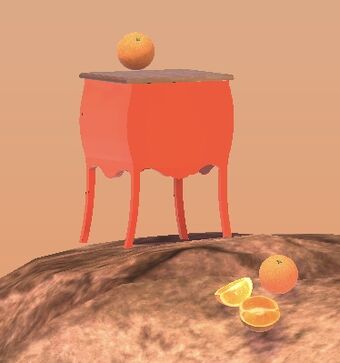
Getting Over It With Bennett Foddy (GOI for short) is the absolute limit of how far you can get with a single game mechanic. The only mechanic is moving around a hammer, attached to a man in a cauldron.
With this control scheme you can push and pull yourself along the ground, pull yourself up using holds, fling yourself, swing under holds, pogo to launch yourself, and so on.
This method of control is incredibly sensitive, and fiddly, but the game ramps up to requiring you to use it in extremely precise and demanding circumstances, at high risk of losing your progress.
GOI can be incredibly frustrating, because there are no permanent checkpoints, and many of the toughest challenges set you up to lose massive amounts of progress. Playing the game at all with it’s strange and difficult control scheme seems impossible, so redoing the incredibly precise tricks it has you perform can seem impossible.
GOI has one level, shaped like a big cone that spreads out as it rises up, having you cross over your earlier paths as you ascend, creating horseshoe shaped level design. This means that if you fall, you’ll land on an earlier section. Because there are no checkpoints, this means you can easily restart the whole game in a matter of seconds, no matter how high up you are.

GOI’s precise skill challenges combined with the potentially unlimited penalty for failure creates an environment where inevitably, no matter how far along you are, you will eventually repeat the entire game from scratch, just to get back to where you were. On a first playthrough, you will need to do this a massive number of times. The side effect of this is that if you are persistent, you will improve at each of these earlier sections until they are nearly trivial, whereas when you started they might have seemed completely impossible.
One of the other genius parts of GOI is that the physics based gameplay allows you to go extremely fast. This means that not only are early parts easier as you master them, but you’ll actually complete them faster each time, and thus it’s not quite so tedious to repeat, as long as you have that improvement mindset.
GOI is one of those rare games where I feel like the Speedrun is very representative of intended play. It doesn’t use any glitches, it just plays the game in the same way players ordinarily do, but very well. A first time playthrough of GOI can take 9 to 20 hours. A speedrun can complete the game in under 2 minutes. The range of variability in how quickly and consistently you can overcome the game’s skill challenges is massive, which is a strong indicator of depth. The repetition of falling down and climbing up again forces you to build your skills and consistency as you play, getting faster each time you reattempt an obstacle, which is really awesome.
GOI’s use of physics makes it very nuanced to control. The man in the cauldron has a rotation and velocity that is separate from, but connected to the hammer. The hammer moves via an inverse kinematics rig, only the head having actual collision with the environment, and acceleration of the hammer is important and can translate to hurling yourself with more force. The hammer has a unique asymmetrical trapezoidal shape, and the cauldron has round sides, but a flat bottom. Together these all mean that your character can touch the environment in a lot of different ways, and have different interactions based on how they make contact, the direction of overall movement, and the direction that force is applied. It’s very easy to grab a hold the wrong way with your hammer, or set up a pogo the wrong way, in the wrong direction. It’s easy to overcommit or undercommit to a movement, especially since your mouse does not have 1:1 control of the hammer, and there is a slight delay.
The game is also careful to steadily ramp up its challenges, with early ones having more definitive holds to grab onto, and later ones having you pull yourself along smaller and smaller holds in stranger directions until you’re pulling along practically flat surfaces. You’re expected to use more force to hurl yourself as the game progresses, and redirect your momentum midjump to get started moving, then go the way you need around obstacles. You can then take these skills and apply them to clear earlier parts of the game more easily as you inevitably repeat them. The game steadily ramps you up to climb flatter and steeper surfaces with a straight pulling motion, culminating in sheer “flat” ice cliffs (they’re not really flat and they have a lot of traction).
GOI gets a 9/10 from me, it cannot get higher without adding more mechanics, but it is absolutely a must-play. It is difficult to play and harder to master, but there’s a wide range of skillful expression possible in it. It recaptures a lot of the consistency challenge that made arcade games fun, while allowing you to complete it blindly fast as you improve, so the early parts are never stale. It goes to show the absolute limit of how nuanced a mechanic can be and is perhaps the gold standard of any single mechanic.
